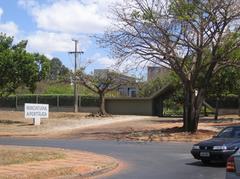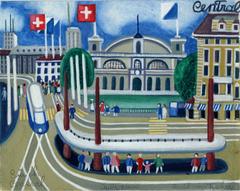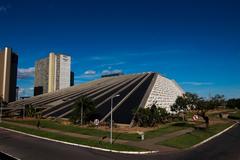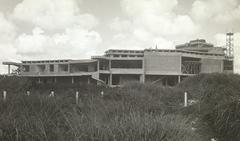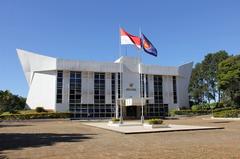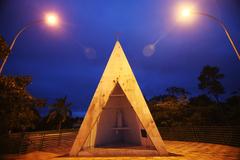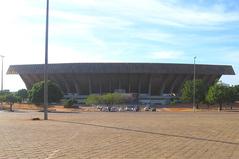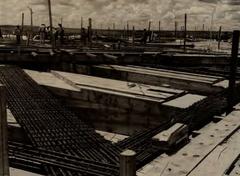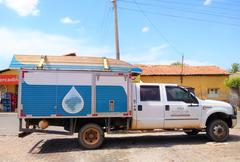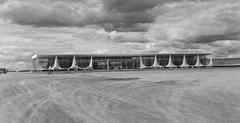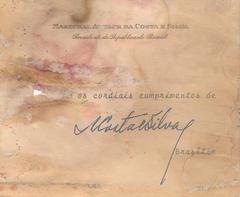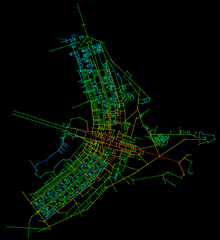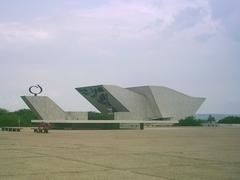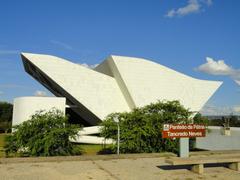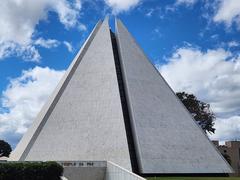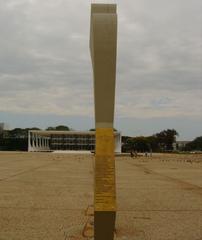
Palácio do Buriti Visiting Hours, Tickets, and Brasília Historical Sites Guide
Date: 04/07/2025
Introduction: The Significance of Palácio do Buriti in Brasília
Situated at the heart of Brazil’s capital, Palácio do Buriti is an emblem of Brasília’s political, cultural, and architectural ambition. As the official seat of the Federal District Government, the palace stands as a testament to Brazil’s mid-20th-century modernization drive and the city’s unique modernist design. Conceived by architect Mauro Jorge Esteves during Brasília’s rapid construction in the late 1950s, Palácio do Buriti reflects the spirit of national unity and democratic governance. Its name, inspired by the native buriti palm, links the structure to Brazil’s cerrado ecosystem and natural heritage.
More than a government building, Palácio do Buriti offers visitors the opportunity to engage with the narrative of Brasília’s innovative urban identity. Its glass façades, landscaped gardens, and curated artworks narrate both the city’s history and forward-looking vision. While primarily an administrative center, the palace periodically opens for public tours and cultural events, providing insight into local governance and architectural evolution. Its central location along the Monumental Axis places it amidst key landmarks, making it an essential stop for anyone exploring Brasília’s monumental core (World History Journal; Wikipedia: Brasília; Secretaria de Estado de Governo do Distrito Federal).
This guide delivers detailed information on visiting hours, ticketing, accessibility, and nearby attractions, ensuring a comprehensive experience of Palácio do Buriti and its role within Brasília’s historic and contemporary landscape.
Contents
- Introduction to Palácio do Buriti and Its Significance
- Historical Background and Architectural Context
- The Genesis of Brasília and the Role of Palácio do Buriti
- Architectural Features and Design Principles
- Construction and Early Years
- Cultural and Civic Importance
- Symbol of Modern Governance
- Art, Gardens, and Public Engagement
- Heritage Recognition and Preservation
- Visitor Information
- Location, Accessibility, and Practical Travel Tips
- Visiting Hours, Ticketing, and Security
- Guided Tours and Educational Programs
- Facilities and Amenities
- Architectural Highlights and Praça do Buriti
- Nearby Historical Sites and Attractions
- Frequently Asked Questions (FAQs)
- Summary and Essential Travel Tips
- Official Sources and Further Reading
Historical Background and Architectural Context
The Genesis of Brasília and Palácio do Buriti
Brasília, inaugurated in 1960, emerged from a bold vision of national integration and modernization under President Juscelino Kubitschek. Designed by Oscar Niemeyer (architecture) and Lúcio Costa (urban planning), the capital was intended to symbolize progress and unity. Within this context, Palácio do Buriti was conceived as the Federal District Government’s headquarters. The palace’s name honors the buriti palm, a native symbol of the cerrado biome surrounding the city, further embedding the building in the region’s identity (World History Journal).
Architectural Features and Design Principles
Palácio do Buriti stands out as the only major government palace in Brasília not designed by Niemeyer. Mauro Jorge Esteves, collaborating closely with the city’s leading architects, created a structure defined by the hallmarks of modernism: clean lines, geometric forms, open spaces, and seamless integration with the landscape. The use of reinforced concrete, marble, and expansive glass panels emphasizes both transparency and functionality (Wikipedia; Let’s Hotels).
The complex consists of a three-story main building with white and beige marble finishes, complemented by a 16-story annex tower. The annex’s verticality contrasts with the main building’s horizontal emphasis, reflecting Brasília’s modernist dialogue between form and function.
Construction and Early Years
Construction of Palácio do Buriti commenced shortly after Brasília’s inauguration and was completed in the early 1960s, aligning with the city’s rapid development schedule. The palace quickly became the nerve center for district governance, housing the governor’s office and major administrative bodies. Despite early challenges in establishing a new capital in Brazil’s interior, Palácio do Buriti solidified its role as both a symbol and a center of effective governance (World History Journal).
Cultural and Civic Importance
Symbol of Modern Governance
Palácio do Buriti embodies Brasília’s modern identity, projecting ideals of efficiency, transparency, and progress. Its prominent location along the Monumental Axis places it at the heart of the Federal District’s administrative and symbolic life. The reference to the buriti palm and surrounding gardens reinforces the connection between civic purpose and the region’s natural heritage (World History Journal).
Art, Gardens, and Public Engagement
The palace’s interiors and public areas feature works by prominent Brazilian artists, such as the mural “Sonhos, Realidade e Esperança” by Ruben Zevallos. The Salão Branco and Salão Nobre host official ceremonies and art exhibitions, while the exterior gardens—home to over 100 mango trees and the iconic buriti palm—underscore Brasília’s integration of nature and modernism (Let’s Hotels).
Praça do Buriti, spanning 47,000 square meters, features reflecting pools, gardens, and monuments like the Lupa Capitolina, symbolizing Brasília’s international connections. The square serves as a venue for public demonstrations, cultural fairs, and everyday leisure, reinforcing the democratic ideals at the city’s core (Audiala).
Heritage Recognition and Preservation
Brasília’s original urban core, including Palácio do Buriti, was designated a UNESCO World Heritage Site in 1987 for its outstanding modernist urban planning and architecture (Wikipedia: National Congress Palace). Ongoing preservation ensures the palace’s cultural and architectural integrity, with regular maintenance of gardens, water mirrors, and artistic features.
Visitor Information
Location, Accessibility, and Travel Tips
Address: Setor de Administração Municipal, Quadra 9, Lote 1, CEP 70075-900, Brasília, DF, Brazil
Access: The palace is centrally located along the Monumental Axis, adjacent to key landmarks like Palácio do Planalto and the National Congress. Public transport (buses) and ride-sharing services provide convenient access. Parking is limited; early arrival is recommended (Secretaria de Estado de Governo do Distrito Federal).
Visiting Hours, Ticketing, and Security
- Opening Hours: Monday to Friday, 9:00 AM to 5:00 PM. Public access is primarily during scheduled guided tours or special events, such as Brasília’s anniversary.
- Admission: Free of charge, but advance booking is required for guided tours via the GDF Cultura website or palace administration. Valid photo ID is mandatory for entry.
- Security: Expect security screening (metal detectors, bag checks). Prohibited items include weapons, sharp objects, and professional photography equipment without authorization. Dress respectfully, especially during official ceremonies.
Guided Tours and Educational Programs
Guided tours—conducted mainly in Portuguese, with English and Spanish available on request—cover the main lobby, ceremonial halls, and select meeting rooms. Tours are limited in size (15–20 people) and require advance booking. Special events may provide access to additional areas and unique programming.
Facilities and Amenities
- Wheelchair-accessible ramps, elevators, and adapted restrooms are available.
- Waiting areas and an information desk are provided during public events.
- Nearby cafés and restaurants can be found within a 1 km radius.
Architectural Highlights and Praça do Buriti
Key Features
- Main Building: Three stories, marble-clad, with large glass façades for natural lighting and visual integration with gardens.
- Annex Tower: 16 stories, housing various government departments.
- Praça do Buriti: 47,000 m², with two large reflecting pools, lush gardens, concrete benches, playgrounds, and the symbolic buriti palm.
- Art and Monuments: Interior murals, a bust of Che Guevara, the Capitoline Wolf statue, and other sculptures create a unique blend of civic, artistic, and historical elements (Let’s Hotels; Audiala).
Urban Integration
The palace and square are strategically placed in the Civic-Administrative Zone, fostering efficiency and symbolic unity. The gardens and water features offer a tranquil escape, while the square’s design supports public gatherings and democratic engagement.
Nearby Historical Sites and Attractions
- Praça dos Três Poderes: The symbolic heart of Brazilian government, uniting the executive, legislative, and judiciary branches (Adventure Backpack).
- Palácio do Planalto: The President’s official workplace, offering guided tours and a popular changing of the guard ceremony (Lonely Planet).
- Congresso Nacional: Iconic twin towers and domes; guided tours reveal legislative processes and architectural vision.
- Palácio da Alvorada: The presidential residence, admired for its lakeside modernist beauty.
- Palácio do Itamaraty: Ministry of Foreign Affairs, noted for its arches and Burle Marx gardens.
- Palácio da Justiça: Known for its exterior water features and striking design.
- Catedral Metropolitana: Hyperboloid cathedral with stunning stained glass.
- Centro Cultural Banco do Brasil & National Museum: Contemporary art and cultural exhibitions.
- Parque da Cidade & Lago Paranoá: Expansive park and artificial lake for recreation and relaxation (Pelago).
Frequently Asked Questions (FAQs)
Q: What are Palácio do Buriti’s visiting hours?
A: Monday to Friday, 9:00 AM–5:00 PM. Public access is by appointment during guided tours or special events.
Q: Is there an entrance fee?
A: No, admission is free but requires advance booking.
Q: Are guided tours available?
A: Yes, tours can be booked via the GDF Cultura website or through the palace administration.
Q: Is the palace accessible for people with disabilities?
A: Yes, the site is equipped with ramps, elevators, and adapted restrooms.
Q: Can I take photos inside the palace?
A: Exterior photography is generally allowed; interior photography requires permission.
Summary and Essential Travel Tips
Palácio do Buriti is a cornerstone of Brasília’s modernist heritage and a living institution at the center of the capital’s political life. Its innovative architecture, symbolic gardens, and civic spaces invite exploration and reflection. When planning your visit:
- Book tours in advance and bring an ID for security.
- Wear comfortable shoes for exploring the extensive grounds and nearby sites.
- Check for special events or open days for exclusive access.
- Combine your visit with other landmarks along the Monumental Axis for a comprehensive Brasília experience.
- Consult official resources for the latest information (Secretaria de Estado de Governo do Distrito Federal; Audiala guide; World History Journal).
Official Sources and Further Reading
- World History Journal: History of Brasília
- Wikipedia: Palácio do Buriti
- Let’s Hotels: Palácio do Buriti
- Secretaria de Estado de Governo do Distrito Federal
- Pelago: Brasília Things To Do
- Adventure Backpack: Brasília Landmarks
- Audiala Guide: Praça do Buriti


